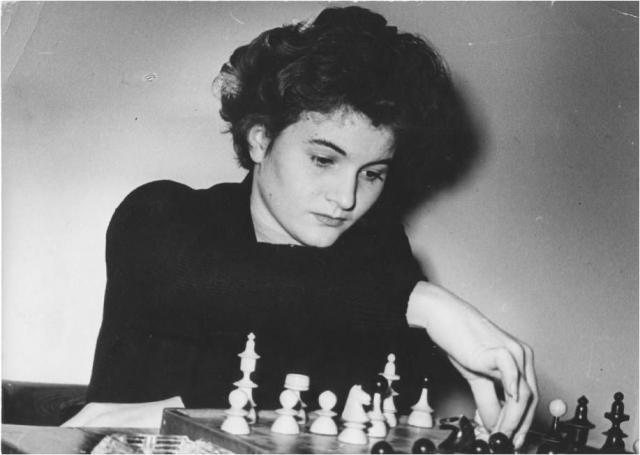
In Memoriam: Milunka Lazarević (1932 - 2018)
The legendary Serbian player Milunka Lazarevic (Милунка Лазаревић in Serbian, Dec 1, 1932 - Dec 15, 2018), the female Tal, is not with us anymore. She will be remembered for always playing for a win, always playing for the first place in a tournament ― everything else was just a disappointment for her. The second place was the same as the last. She was famous for her exciting and uncompromising playing style and having an unimaginable fighting spirit.
She despised draws, always preferring to play until the very end of possibilities. Even when, a full point ahead of the competition, playing a highly important, last round game that could have earned her a ticket to play for the world championship.
Early in her career she was setting goals on how to improve her game. One of the goals she set was to play a tournament without a draw. So she achieved 100 percent performance in the 1957 championship of, back then, the second strongest chess nation, Yugoslavia. She made it one year before Fischer did the same in the US championship.
Her inspiring style of play, plus the aura of one of the most beautiful chess players, gave her an enormous popularity, not only in her native country. For example, during traditional matches between USSR and Yugoslavia, she would receive ovations from the audience of the strongest chess nation that knew chess very well; they greatly appreciated her creative, unbendingly aggressive style.
Here is the chess Master, author and journalist Anatoly Matsukevich (he coached and helped the young Karpov get the Master title when he lived in Tula; he also co-authored a few books with Karpov),
"For me, December starts on the first, not because all months do so, but for the fact that on the December first came to the world Milunka Lazarevich. The beauty of Milunka was not a God's gift for only one person. She became a treasure of the entire chess community. If one should put together, in one bunch, all hearts won by Milunka, I feel pride that my small heart would also be a part of that magnificent bouquet."
There is a story that after sacrificing few pieces to Smyslov (the Bled Candidates, 1959), Misha Tal got off the table and came to Milunka, sitting in the first row, saying, "I did it for you, Madame!"

Milunka learned chess at 15. It was on a Christmas Eve night. Her father and brother were playing chess, while she wanted to play cards that night. "Come on, we are going to teach you how to play." So in five minutes, they showed her the Scholar's mate and how pieces move.
In 1950, Yugoslavia hosted the Chess Olympiad. In the absence of USSR (due to the 1948 rift between Stalin and Tito), Yugoslavia won the gold. Numerous events took place all over country throughout the year. Milunka won the school tournament. The second place in the championship of the city of Novi Sad qualified her to play in the championship of the province of Vojvodina. The best junior result. Good play entitled her to participate in the Yugoslav championship in Split that year. Again, the best junior. She still doesn't know chess notation and what the smothered mate is (in the same tournament, she became a victim of it in a position with a piece up).
As a born fighter, Milunka sweared that things would look different next year She firmly decided to take up chess seriously now. She was 18 when she joined the Novosadski Chess Club. Her instructor was Zarko Popovic. He told her she would become the world champion if she worked hard.
Chess literature was scarce during that time. She studied from Magyar Sakkvilag, Capablanca's Fundamentals and Fine's endgames, while she only wanted to deliver a checkmate, quick.
All hard work enabled her to win the Serbian, and to came in second in the Yugoslavian championship of 1951. In 1952 she already shared the first place with Dr Vera Nedeljkovic, her fierce rival and colleague from the national team for many years thereafter. She won the Yugoslav championship 11 times, last time in 1982. Petrosian worked it out that both of them had been part of the top elite for 25 years.

In the 2nd Women's Chess Olympiad (Split, 1963), Milunka played on board 1. My Professor from college, Dr Verica Nedeljkovic scored perfect 12/12 on board 2. The Yugoslavs (Lazarevic, Dr Nedeljkovic, Katarina Jovanovic) won the Silver (24.5, W12 D2 L0), only a half point behind the USSR (25, W12 D2 L0, Nona Gaprindashvili, as the World champion, Tatiana Zatulovskaya, Kira Zvorykina). The Yugoslav coach forced Milunka to go on playing in a draw position with Gaprindashvili. as Nedeljkovic stood worse in her game against Russians. Eventually, Nedeljkovic won, and Milunka lost (the coach resigned after the Olympiad because of this).
Milunka had a chance to play the match for the world championship the following year. She was leading in the Candidates tournament in Sukhumi one point ahead of Tatiana Zatulovskaya and Alla Kushnir before the last round. She beat them both in the tornament. As always, she played for a win in the last round against the American Gisela Gresser, and lost. In the play-offs, she won the first two games, while Zatulovskaya and Kushnir drew. 1.5 point ahead of the Russians. Then lost two games, so Kushnir got the chance to play Gaprindashvili for the championship.
Karpov's favorite piece was Rook. For Misha Tal it was King, the opponent's one. Queen was Milunka's favorite. When coupled with a Knight, she was very dangerous. She wisely used her Queen power and would swing it into action to release its energy at the right moment.
On one occasion, Botvinnik, Polugaevsky, Geller and Milunka sat together when the patriarch said jokingly to Milunka, "You must be one of ours. Lazar is our name." She replied, "We had the Prince Lazar who fought Turks at the Kosovo field in 1389. If I had only one drop of Jewish blood I would have long time ago become a world champion!"
Who could better define Milunka's playing style than Nona Gapridanshvili, the sixth women's world champion (theirs was a great rivalry in the 60-70s; in 1974 Nona was awarded the first WGM title, Milunka got the second in 1976). I ran online across this article in Russian from Gaprindashvili's book I prefer risk (each female world champion got one page from Nona in it; Milunka got five).
In the article, Nona writes about her game of the life with, you bet, Milunka (the game found its place in some chess 'best' lists, for example, 100 Awesome moves by Eric Schiller, and probably deserves a post on its own).

Milunka Lazarevic and Nona Gaprindashvili
.
The excerpt that follows beautifully depicts Milunka's attitude toward chess (something we are kind of missing nowadays).
"She is of an artistic nature, even of a Bohemian spirit. In chess she is only attracted to attack, combinations and sacrifices. When it comes to positional play, to the, so called, accumulation of small advantages, she expresses open dislike, not to say disgust.
"With such a style, you are possessed of the "madness of the brave." It doesn't matter who her opponent is, it could be a very strong one too - she will still sacrifice pawns, pieces - just to seize the initiative and create an attack. In this insatiable thirst for offensive, offensive at any cost, lie both the strength and the weakness of Milunka.
"Devoid of any prosaic calculations, Milunka can go for a pawn, even a piece sacrifice, sometimes for no other reason but a mere passion for beauty. But when all the prerequisites for an assault are in place, she is extremely dangerous.
"With such a style of play, it comes with no surprise then that she just overwhelms weaker opposition without much trouble. When meeting strong players, much, if not all, depends on who has the initiative. As you might guess, Milunka Lazarevich practically neglects the opening theory: as White she plays Bird, as Black, depending on the opponent’s first move, Sicilian or Dutch. An improviser by nature, she puts the main emphasis on the middlegame. It is her native element, where Milunka feels like a predator, sort of shark of the chess ocean.
"Committed to only two or three openings, she is always facing a serious challenge: she goes into battle with an open visor, without tricks and cunning. She seems to be saying to her opponents: you know everything about me, here I am, standing right in front of you with no tricks up my sleeve, let's start a chivalrous and uncompromising fight!
"I speak with such passion of Milunka because her playing style does make an impression on me. I can't help but like Milunka's risky sacrifices even when she herself finds it unlikely to work. She sees it and... can't do anything with herself, she can't resist temptation, and loses in the end. I can't help but like Milunka's playing style, for Milunka the artist gains the upper hand over Milunka the point-grabber, at those moments when feeling overcomes reason. Although I myself usually find a balance between creativity and competitiveness, this romantic approach is very much in the spirit of my Georgian and chess character."
Nobody could have left a more fitting chess epitaph for Milunka!

